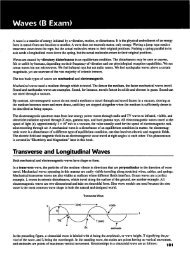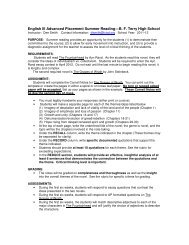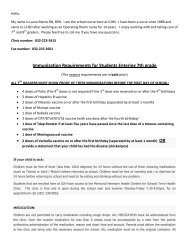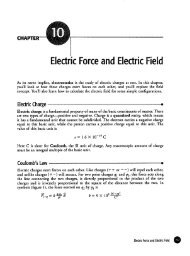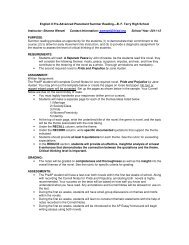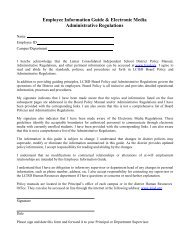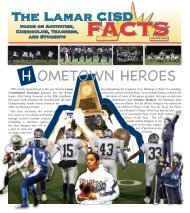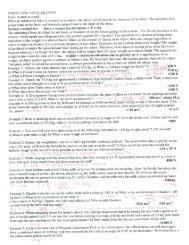REAL BOOKS VS. E-BOOKS AND COMPUTERS?
REAL BOOKS VS. E-BOOKS AND COMPUTERS?
REAL BOOKS VS. E-BOOKS AND COMPUTERS?
You also want an ePaper? Increase the reach of your titles
YUMPU automatically turns print PDFs into web optimized ePapers that Google loves.
task is done less well. Although there isremote hope that the brain developmentof today’s “digital natives” will adapt itselfto multitasking better than their parentswere able to do, there is no research tosupport it. None. Heavy multitaskers loseevery time, no matter which generation.How are the e-scores?Not so good. In fact, Steve Jobs, in hisfinal weeks, bemoaned to Bill Gates theirfailure to improve education scores withed-tech. Since U.S. schools spend $2.2billion annually on education software, it’sstartling when Microsoft’s former executivedirector for education summarizes e-learning this way: “The data is prettyweak. It’s very difficult when we’repressed to come up with convincing data.”One Sunday in 2011 whenmillions of newspaper readerswere being told by theAssociated Press that 600school districts were adoptingApple’s new iPads, theNew York Times devoted two full pages toKyrene, Arizona, and its e-learning programthat had cost $33 million to-date.The ed-news from Kyrene: No change inschool scores after six years and all thatclicking.Ultimately, the adults may have to concedethat, beyond the gadgets, we’re dealingwith immature human beings, and justbecause we wire the school or wire thehome doesn’t mean we’ve wired thebrains. Fourteen-year-olds act like 14-year-olds, Wi-fi or not.E-behavior today and tomorrowTraveling these days I am continuallyaware of the faces of young people, isolatedin their LED-lit cocoons, bent over the devicesat dinner tables, in cars, school hallwaysand parking lots, walking along thesidewalk. Despite being surrounded bypeers and parents, their focus is foreverdownward, like a tribe of tiny hunchbacks.They’re getting better at texting and playingvideo games but worse at interpersonalskills. When neural routes devoted to socialskills are underdeveloped in childhood,they don’t miraculously blossom at age 21.This will pose problems for the “digital natives”when the time arrives to interact eyeto-eyewith customers or coworkers.The e-verdictSo here we are—confronted by theInternet and its tools, the most far-reachingman-made creation in history (short offire), a device so powerful it has reducedthe globe to the size of a village and powerfuldespots to has-beens. And like anythingpowerful—bombs or drugs, love or hate,ultimately it comes down to how we behavewith it—our self-control. And most of thatself-control will have to begin at home,where parents either limit children’s accessto such powerful tools or teach the selfcontrolby example. That may be the ultimatee-challenge—if the parent can get offthe smartphone long enough to do it.eMore facts and footnotes on this material can befound in the forthcoming seventh edition of TheRead-Aloud Handbook (Penguin 2013). © JimTrelease 2012. For other brochures, see:www.trelease-on-reading.com/brochures.html<strong>REAL</strong> <strong>BOOKS</strong> <strong>VS</strong>.E-<strong>BOOKS</strong> <strong>AND</strong><strong>COMPUTERS</strong>?Why not digitize thelibrary and savemoney? Not so fast.BY JIM TRELEASEAuthor of the New York Times BestsellerThe Read-Aloud Handbook
In the spirit of full disclosure, I confess toowning four Apple computers, an iPod, aniPad, and average several hours a day working,creating, and shopping via the Internet.I’m a big fan of technology—but not a blindone. I’m also 71 years old. Is there a differencebetween an easily distracted 12-year-oldand a 71-year-old?E-books are the future. Who needsold-fashioned printed books?In 2009, a high school library (CushingAcademy) outside Boston gave away20,000 books and went all-digital, raisinga l i t e r a r yclamor andb r i n g i n gmany questionsto thef o r e f r o n t .This shortb r o c h u r ea d d r e s s e ss o m e o fthem.Cushing’s library had become primarilyMaecenas a reference pulvinar library. Since sagittis most enim of theteachers Lorem ipsum were dolor doing sit amet, their ligula research suspendisse online,nulla students pretium, were rhoncus following tempor placerat suit fermentum,enim was integer becoming ad volutpat. a ghost-room. Nisl rhoncus turpis Re-and thelibraryest, vel elit, congue wisi enim nunc ultricies sit,modeledmagna tincidunt.now asMaecenasa digitalaliquamreferencemaecenaslibrary,ligula complete nostra, accumsan with taciti. a cyber Lorem ipsum cafe dolor andlooking sit amet, much ligula like suspendisse a classy nulla Starbucks, pretium, rhon-it’cusmost tempor popular placerat. Lorem spot ipsum on campus. dolor sit amet, Withtheligula suspendisse nulla pretium, Nisl rhoncusCushing congue. students paying $50,000 a yeartuition, it’s going to be a long, long timebefore most schools can follow thatmodel. Most private academy studentscome from homes with rich personal libraries—notso with one-third of Americanchildren who cannot afford priceydigital reading devices.And while there is a myriad of onlineintellectual resources (like Khan Academy)available for the young, there areother concerns that even the privateschools need to be thinking about as wedebate e-learning among the young.Format longevity?Before we dump too many “dead tree”books, consider the staying power of digitalformats. Tried to read a Word documentthat was created a decade or twoago? Big problem there. Will today’s e-books be out-of-format in twenty years,like old 78-rpm records or VHS movies?One further concern relates to books asa social experience; that is, the ones we loveso much we’re compelled to pass them onto a friend: “You’re going to love this!”Impossible to do with an e-book. Onlyyou can enjoy it, thus short-circuiting thesocial aspect. Used-e-bookstores? Nope.Print versus pixelsA word on a clay tablet or a parchmentscroll or a printed page—it still means thesame. If it’s pixelated on an e-tablet, it stillholds the same meaning. But does it stayin the mind as long afterward? Brain scienceraises serious questions about digitalwords’ staying power in the memory.When 100 students, half with digital materialand half with printed material, aretested on that matter, students with theprinted text consistently score higher.Studies of eyem o v e m e n t swhile readingonline showonly about 18percent of aWeb page isactually read(10 seconds or less), a pattern that canbe habit-forming for the young.Brain gain vs. brain drainI will be the first to admit the to richnessof the Internet world, the vastnessof its instant information. Imagine theadvantages it gives today’s physiciansand scientists, to say nothing of remotevillages across the globe that now canaccess information that once was onlyfor the privileged few. But it does haveit’s downsides that must be addressedand overseen.E-tablets (like Kindle Fires andiPads) with text that includes hyperlinks(underlined passages that connect toWeb pages) are proven to slow readingand impede understanding, as do computerscreens. The links (to say nothingof email alerts) are ever-present distractions.As one scientist put it, when theundisciplined reader tries reading onsuch devices, it’s often like trying to readwhile simultaneously doing a crosswordpuzzle.As students attempt to study fromsuch devices while simultaneously texting,uploading or downloading music,and Web surfing, the end result: Every







